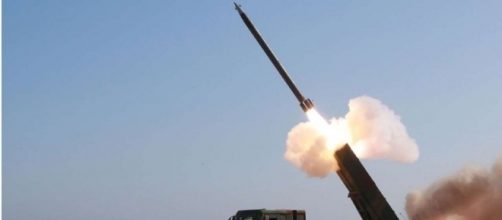THAAD, developed by the United States is being installed in South Korea while North Korea conducted massive artillery drills to celebrate the 85th anniversary of the founding of its military. Obviously, the situation in the region is volatile, and the slightest provocation could lead to a disaster.
Setting up THAAD
According to New York Times the THAAD (acronym for Terminal High Altitude Area Defense) system developed by the United States is being installed in Seongju, 135 miles southeast of Seoul and as per indications, it could become operational by the end of the year.
South Korea is believed to have developed a radar that can detect incoming artillery faster and more accurately than the present radar it uses. The technology, to be deployed by 2018, cannot intercept the rockets but would be able to guide the military to identify the source more efficiently and strike the launch pads.
Military activities of North and South Korea
North Korea undertook drills near the country’s east coast. A news agency revealed that there were 300 to 400 pieces of long-range artillery involved and these were similar to the ones deployed along the border north of Seoul which lies in the range of the North Korean artillery. It could lead to a catastrophe in the event of war.
Observers noted that there was no nuclear or long-range missile test for whatever reasons and Kim Jong-un decided to celebrate the anniversary with a large demonstration of conventional weapons.
Incidentally, the drills of North Korea coincided with military maneuvers conducted by the United States and its allies. The US Navy described the arrival of Michigan, a submarine armed with Tomahawk cruise missiles, in the port city of Busan, South Korea, as “routine.”
However, its arrival added to the tension and reflected the heightened military readiness on both sides of the Korean Peninsula. Simultaneously, the Navy’s Seventh Fleet indicated that a strike group led by the aircraft carrier Carl Vinson was engaged in conducting exercises with Japanese forces in the Philippine Sea.
These activities are gradually becoming areas of concern for those in authority.
China is in a fix
China, a longtime ally of North Korea, is losing its patience and is worried about its erratic behavior.
President Xi Jinping has tried to mediate in the trouble brewing between the United States and North Korea and wanted Donald Trump to exercise restraint in dealing with Pyongyang which is intent on carrying out another blast. This is because North’s atomic test site in Punggye-Ri is being readied for another activity.
With the United States, Japan, China, North Korea and South Korea in the field and with each of them each having his own unique agenda, the future appears to be one of confusion. There is bound to be a polarization of power, and the requirement is for a strong leader to emerge who will not be afraid to call the shots and also ensure that it does not escalate into a war.

